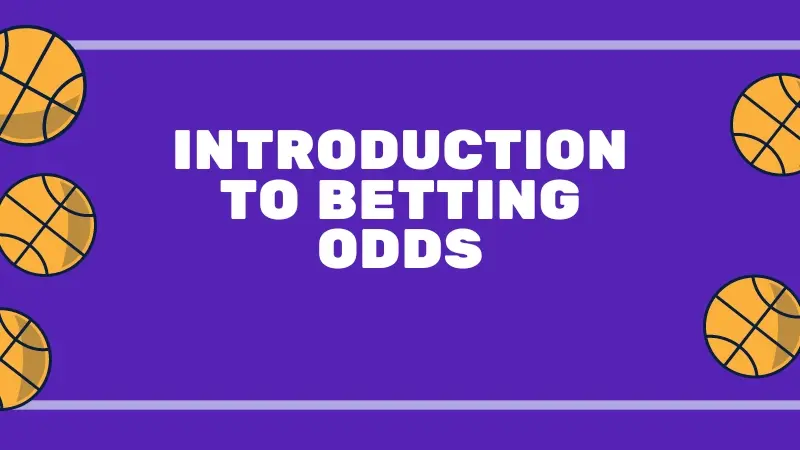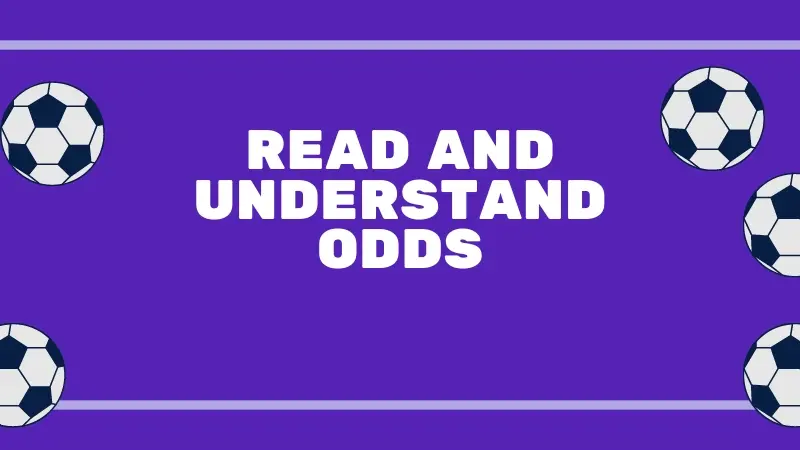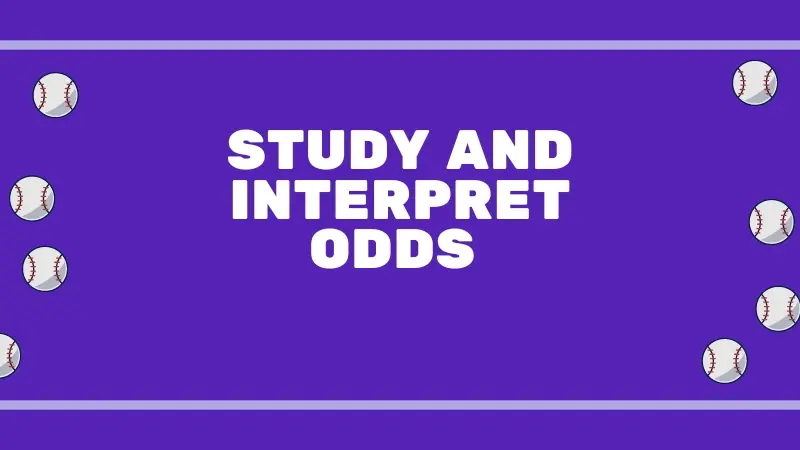INTRODUCTION TO BETTING ODDS

Understanding odds is fundamental in betting. The odds reflect the likelihood of a given outcome and the potential return on your bet. Mastering this concept is key to successful betting.
DEFINITION AND IMPORTANCE OF UNDERSTANDING BETTING ODDS
Betting odds are numerical expressions of the likelihood of an event happening in sports or other competitive events. The concept is integral for both the bookmaker and the bettor. For the bookmaker, odds enable them to calculate the potential payouts on different bets. For the bettor, understanding odds is crucial in making informed decisions about where to place their bets and how much to wager.
Odds can appear complex, but they’re simply a way of expressing probability. For every possible outcome of an event, there’s a probability that it will occur. These probabilities are then converted into odds by the bookmaker. The odds offered often reflect not just the mathematical probability of an event but also the bookmaker’s assessment of that probability.
Understanding betting odds, therefore, is key to successful betting. It allows bettors to assess the potential value of a bet, to compare odds between different bookmakers, and ultimately, to make more informed betting decisions; Without a firm grasp of how odds work and what they represent, a bettor is essentially betting blind, which is a strategy that rarely leads to long-term success.
HOW TO READ AND UNDERSTAND ODDS IN BETTING

Reading betting odds entails understanding their format, interpreting their implied probability, and assessing their value, which all combine to inform your betting decisions.
EXPLANATION OF ODDS FORMATS
Betting odds can be presented in one of three main formats⁚ decimal, fractional, or American. Understanding these formats is crucial to interpreting betting lines effectively.
Decimal odds, popular in continental Europe, are the easiest to understand. They represent the total payout from a successful bet, including the original stake. For instance, odds of 2.00 mean that for every unit staked٫ a successful bet would return two units.
Fractional odds are commonly used in the UK and Ireland. They show potential profit relative to the stake. For example, odds of 4/1 indicate you stand to win four units for every one unit staked, excluding the original stake.
American odds, also known as moneyline odds, are popular in the United States. They show how much a bettor must stake to win 100 units (if negative), or how much a bettor wins from a 100 unit stake (if positive).
Recognizing and interpreting these formats can help bettors compare odds and identify value across different markets and bookmakers.
UNDERSTANDING THE CALCULATION OF ODDS
To truly understand odds in betting, one must be familiar with how they are calculated. The process is intrinsically linked to probability. Bookmakers begin by assessing the likely outcome of a sporting event. This involves considering all pertinent factors such as a team’s current form, head-to-head statistics, player injuries, and even weather conditions. Based on these factors, the bookmaker will assign a probability to each potential outcome.
To convert this probability into odds, the bookmaker simply uses the formula⁚ odds = 1/probability. For example٫ if a team has a 50% chance of winning٫ the decimal odds would be 2.00 (1/0.50).
However, it’s important to note that the odds provided by bookmakers don’t always reflect the true probabilities. They incorporate a margin known as the “overround” or “vigorish”, which ensures the bookmaker makes a profit regardless of the outcome. This margin can affect how bettors should read and interpret odds.
Understanding the calculation of odds is key to making informed betting decisions. It helps you decipher what the odds imply about the probability of different outcomes and how much you stand to win or lose. As such, familiarity with the calculation process is a fundamental aspect of betting wisdom.
HOW TO STUDY AND INTERPRET ODDS IN SPORTS BETTING

Studying and interpreting betting odds is crucial for profitable betting. It involves careful analysis, understanding probability, and recognizing value in the betting market.
UNDERSTANDING ODDS IN FOOTBALL BETTING
In football betting, understanding odds translates to comprehending the likelihoods of specific game outcomes. Each set of odds communicates bookmakers’ estimations of outcomes, derived from detailed study and statistical analysis of both teams’ performance history, player forms, and other influential factors like home-field advantage or weather conditions.
Odds in football betting often come in three formats⁚ Fractional (UK), Decimal (European), and Moneyline (American). Each format represents the same probability but in a different way. The Decimal format is arguably the easiest to understand, where odds represent the total payout for a successful £1 bet. For instance٫ odds of 2.00 mean you stand to win £2 for every £1 you wager٫ should your bet be successful.
To maximize your football betting effectiveness, it’s crucial to compare odds across different bookmakers. This practice can reveal value bets, where the bookmaker’s estimated probability is less than the true probability of an event occurring. Understanding these intricacies of football betting odds can significantly enhance your betting strategy and potential return on investment.
USING BETTING ODDS TO DETERMINE PROBABILITY
The cornerstone of successful betting lies in understanding odds and using them to calculate the implied probability. This calculation aids bettors to make informed decisions, providing a clear insight into what bookmakers believe is going to happen in a particular sports event.
In essence, betting odds represent the likelihood of a given outcome. By converting these odds into implied probabilities, bettors can measure whether the bookmaker’s assessment matches their own. If a discrepancy occurs, where the bettor believes the probability of an outcome is higher than what the odds suggest, it identifies a valuable betting opportunity.
Calculating the implied probability from decimal odds involves the formula⁚ Implied Probability = 1 / Decimal Odds. For instance, if the decimal odds are 2.00, the implied probability is 0.50 or 50%. For fractional odds, the formula is slightly different⁚ Implied Probability = denominator / (denominator + numerator).
Understanding this conversion from betting odds to implied probability is invaluable for bettors. It allows comparison of the estimated probability with the actual, enabling more strategic decisions in line with personal assessment and risk tolerance.
HOW BETTING ODDS WORK
Understanding how betting odds work is crucial. They represent the probability of an event’s outcome and determine your potential winnings. They’re essentially a reflection of risk versus reward.
HOW BOOKMAKERS DETERMINE BETTING ODDS
Understanding how bookmakers determine betting odds is vital to become a proficient bettor. At the core, bookmakers set the odds according to the probability of an event’s outcome. They employ experts known as traders or odds compilers who utilize extensive knowledge in specific sports, along with sophisticated mathematical models and algorithms, to assess probabilities.
Essentially, a bookmaker will look at the history, current form, and multiple other factors of the teams or players involved and then assign a probability to each possible outcome. These probabilities are converted into odds.
However, there is another dimension to this process, called the overround. It is the bookmaker’s profit margin included in the odds which ensures that they make money regardless of the outcome. Consequently, the cumulative market percentage is always greater than 100%, manifesting in the odds being slightly less favourable than the actual mathematical probability.
Furthermore, odds can be influenced by the betting volume from other customers. This is because a bookmaker will often lower the odds on the team or player receiving a lot of bets to limit their potential payouts.
THE CONCEPT OF OVERROUND AND HOW IT AFFECTS ODDS
In the context of betting, understanding the concept of overround is integral to evaluate the fairness of the odds offered. Essentially, the overround—also known as vig, juice, or margin—represents the bookmaker’s profit margin, ensuring they make money regardless of the event’s outcome.
It is calculated by converting each set of odds into implied probabilities and then summing these probabilities. In a perfectly fair market, this sum should be 100%. However, in reality, it exceeds 100%, typically ranging between 101% to 120%. The excess percentage represents the overround.
For instance, in a football match, if Team A has odds of 2.00 (implying a 50% chance) and Team B also has odds of 2.00, the sum of their implied probabilities would be 100%. But if both teams had odds of 1.91 (reflecting approximately 52.36% chance), the total probability would be roughly 104.72%, thus an overround of 4.72%.
The overround affects odds by slightly decreasing the potential payout on each bet. The higher the overround, the lower the potential payout, resulting in lesser value for the bettor. Therefore, it is beneficial to choose bookmakers with a smaller overround.
HOW TO CHOOSE THE BEST BETTING ODDS
Choosing the best betting odds involves evaluating various bookmakers, understanding the overround, and identifying value. Mastery of these aspects enhances your betting experience and profitability.
LOOKING FOR VALUE IN BETTING ODDS
In betting parlance, ‘value’ refers to a bet that is likely to win more often than the implied odds suggest. Recognizing value in betting odds is a crucial skill that separates professional bettors from amateurs. It’s not just about identifying who is likely to win, but whether the odds being offered represent good value.
Value is inherently linked with the concept of ‘implied probability’. The implied probability is a conversion of betting odds into a percentage that reflects the bookmaker’s estimation of an event occurring. The key to finding value is assessing whether you believe the probability of an outcome is greater than that reflected in the offered odds.
For instance, if a football team is given odds of 3.00 to win٫ the implied probability is approximately 33.33%. If your analysis suggests the team has a 50% chance of winning٫ there is value in that bet. However٫ understanding if you’re getting value requires expertise and consideration of numerous factors such as team form٫ injuries٫ and historical performance. Hence٫ developing the ability to identify value in betting odds takes time٫ study٫ and experience.
COMPARING BETTING ODDS ACROSS DIFFERENT BOOKMAKERS
Comparing betting odds across different bookmakers is a key strategy in optimizing potential returns from your bets. This practice, known as ‘odds shopping’, involves studying various odds on offer for the same event across multiple betting platforms.
Different bookmakers often have varying odds for the same event due to their unique risk assessments and market focus. By comparing these odds, you can choose the most favorable ones, thereby increasing your potential payout if your bet wins.
For example, let’s consider a football match where Bookmaker A offers odds of 2.00 for Team X to win, whereas Bookmaker B provides odds of 2.10 for the same outcome. By choosing Bookmaker B, you stand to gain more if Team X wins.
Odds comparison can also help identify arbitrage opportunities, where you can bet on all possible outcomes across different bookmakers to guarantee a profit regardless of the result. However, it’s important to note that such opportunities are rare and usually corrected quickly by the bookmakers.
Several online tools are available to simplify this process by displaying the odds from multiple bookmakers in real-time. Utilizing such tools can greatly enhance your efficiency in odds shopping.
BECOMING PROFICIENT AT USING BETTING ODDS
Becoming proficient at using betting odds involves understanding, comparing, and choosing favorable odds. Remember, success in sports betting is a well-balanced mix of knowledge, strategy, and luck.
PRACTICAL TIPS FOR USING BETTING ODDS TO YOUR ADVANTAGE
In order to effectively use betting odds to your advantage, there are several practical tips you can employ. Firstly, understanding the different odds formats is fundamental. Knowing how to read and interpret fractional, decimal, and moneyline odds can aid in your betting decision-making process.
Another crucial tip is to always compare odds across multiple bookmakers. This technique, known as ‘odds shopping’, can significantly increase your potential winnings as you are able to choose the most favorable odds for your selected outcome.
Beyond that, it’s advisable to study the teams or players involved in your selected sports event. Understanding their form, statistics, and other relevant factors can help you make an informed prediction about the probable outcomes, which directly influences the odds.
Lastly, remember to manage your bankroll wisely. Even with the most favorable odds, there’s still a risk of losing your stake. Therefore, it’s essential to bet responsibly, ensuring you only wager what you can afford to lose.
By combining these tips with a solid understanding of betting odds, you can potentially increase your chances of making profitable bets.
